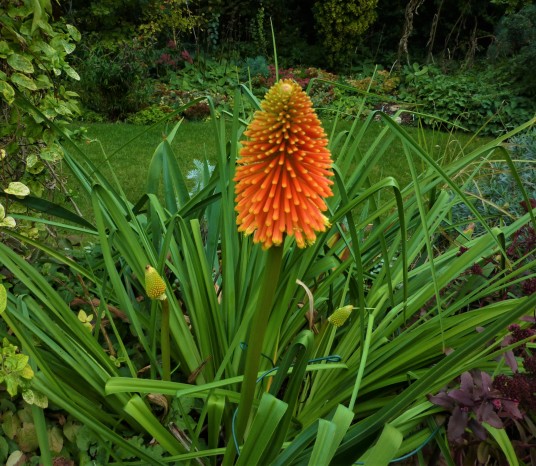Colour
The Michaelmas daisies have been wonderful and are still pretty good. When the sun shone, the bees really appreciated them. These American garden asters have been renamed Symphyotrichum- what a mouthful. I am afraid that I unashamedly stick to Michaelmas daisy, so much more straightforward. I have divided most of the clumps within the last couple of years and now they are flowering with renewed vigour- all except one of my favourites- the shocking pink Symphyotrichum (Aster) novae-angliae ‘Alma Potschke’. She is not doing well and needs to be moved so she is not over-shadowed by her neighbours. I have found the perfect spot and may even move her now, as the weather is mild and damp, rather than waiting until the spring. Next year I should be able to enjoy her in all her gaudy glory.

My Mum’s Nerine bowdenii have responded well to a move and summer sun. The bulbs were producing more and more lush leaves but fewer and fewer flowers. The heavy clay in the border was offering far too rich a diet and they were not getting enough sun. So we dug them out (quite a job as the bulbs had multiplied alarmingly), put some in pots, gave some away and moved others to a sunny well-drained spot. The result – lots of flowers and more to come. A most satisfactory outcome.

….and form
The amazing Willow-leaved or Missouri sunflower (Helianthus salicifolius) is as imposing as ever. The tall stems clothed in long, drooping willow-like leaves reaching up to the sky and now are topped by clusters of small bright yellow daisies. A most improbable and glorious plant, such an entertaining architectural feature in the middle of my bed.
Rooper’s red-hot poker (Kniphofia rooperi) is another hit with the most amazing egg-shaped bright orange-red flowers that fade to yellow-orange. I planted it 2 years ago and it had no flowers last year, but this year four spikes are emerging from between the strappy leaves. Eventually I hope for an eye-catching clump of 4-foot tall flowering stems.

Preparing for Spring
Mr B. cut the mini wildflower meadow on the ha-ha bank, scarified what was left and raked up the loose moss and grass. I have scattered more wildflower seeds on the bare patches and hope the Yellow rattle will do its job and continue to reduce the vigour of the grass. I have planted just a few Fritillaria michailovskyi on one side and Fritillaria acmopetala on the other. It would be lovely if they “do” but I suspect the slugs will go for them, as they have before. I live in hope.


































